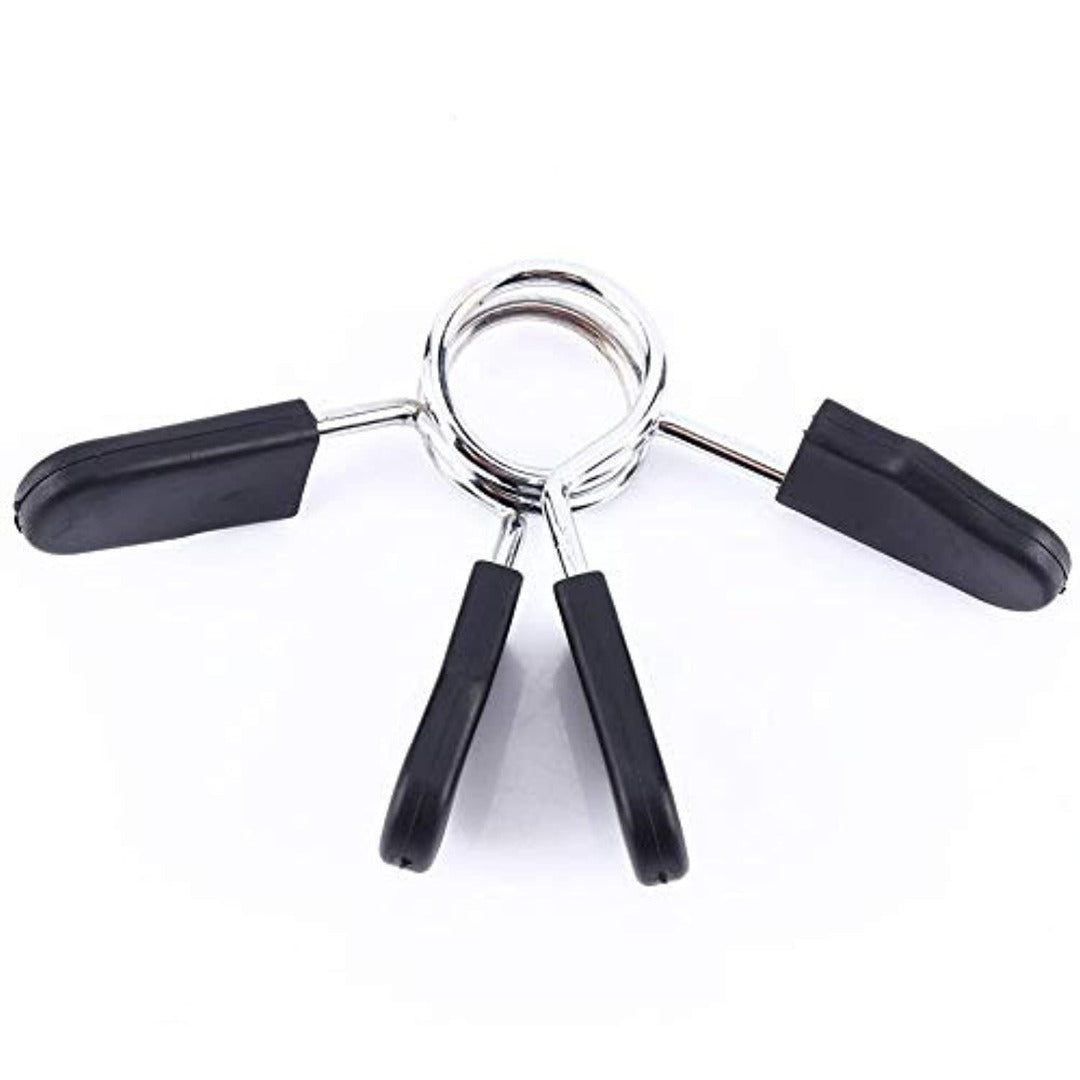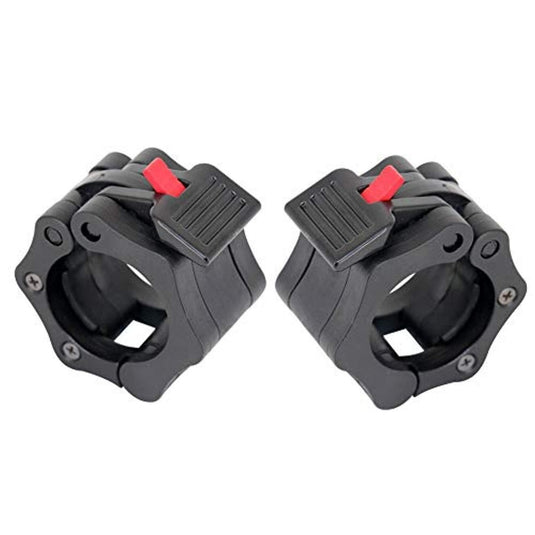Everything you need to know about using the dumbbell closure
Welcome to our dynamic guide about the use of the dumbbell closure! Whether you are a seasoned athlete or just start with strength training, the correct knowledge about the use of the dumbbell clamp is essential to prevent injuries and get the most out of your workout. In this comprehensive manual we will go through all aspects of using the Dumbbell closure, including the right technology, the benefits and the various exercises that you can perform with them. Whether you are interested in improving your fitness routine or want to know more about the correct use of the Dumbbell closure, we have all the answers for you. Time to take your training to a higher level and to take full advantage of this versatile fitness accessory.

Introduction to the Halter clamp
Halter clamps are small but essential tools in the fitness world.
They are used to attach barter slices to a dumbbell rod, so you can train safely and effectively.
In this part of the blog we discuss everything you need to know about halter clamps:
- The different types of halter clamps.
- How to use halter clamps.
- The benefits of using halter clamps.
- Tips for buying halter clamps.
We hope that this information helps you to choose the right dumbbell clamps for your training sessions.
Let's start!
1. The different types of halter clamps
There are two main types of halter clamps:
- Clamp: These clamps are easy to use and adjust. They are suitable for most dumbbell rods.
-
Screw clamps: These clamps are firmer than spring clamps.
They are ideal for heavy weights.
In addition to these two main types, there are various other types of halter clamps, such as:
- Olympic clamps: These clamps are specially designed for Olympic barbells.
- Spinlock clamps: These clamps are quick and easy to use.
- Tire: These clamps are cheap and lightweight.
2. How to use halter clamps
The use of halter clamps is simple:
- Place the halter clamp on the barbell rod.
- Adjust the clamp to the desired position.
- Tighten the clamp.
- Make sure the clamps are stuck well before you start training.
3. The benefits of using halter clamps
Halter clamps offer various benefits:
- Safety: Halter clamps prevent the dumbbell slices from sliding off the barbell.
-
Efficiency: With halter clamps you can perform your training sessions more efficiently.
You don't have to worry about the dumbbell discs that shift. - Comfort: Halter clamps ensure a comfortable grip on the barbell.
4. Tips for buying halter clamps
When buying halter clamps, note the following factors:
- The type of barbing rod: Make sure the clamps are compatible with your dumbbell rod.
- The weight tax: Choose clamps that are suitable for the weights you use.
- The material: Choose clamps of a sturdy material, such as steel or aluminum.
- The price: Halter clamps come in different price ranges. Choose clamps that fit within your budget.
We hope that this information helped you to learn more about halter clamps.
You can train safely and effectively with the right halter clamps.
The anatomy and parts of a dumbbell
In this part of the blog post we discuss the anatomy and parts of a dumbbell closure:
1. The different parts of a dumbbell closure:
-
The body: The body of the dumbbell closure is the main part.
It is made of a sturdy material, such as steel or aluminum. - Bracket: The bracket is attached to the body and clamps the dumbbell discs.
There are different types of brackets, such as spring clamps and screw clamps.
- The button or lever: The button or lever is used to open and close the bracket.
- The Borgmoer: The locking nut ensures that the bracket stays in place.
2. The operation of a dumbbell closure:
A halter closure works as follows:
- Place the dumbbell closure on the dumbbell rod.
- Open the bracket.
- Place the halter discs on the barbell.
- Close the bracket.
- Tighten the button or lever.
- Make sure the dumbbell closure is stuck well before you start training.
3. Tips for maintaining dumbbell closures:
Halter closures are easy to maintain:
- Clean the dumbbell closures after each use with a damp cloth.
- Regularly check the dumbbell closures for wear.
- Replace the dumbbell closures if they are damaged.
By properly maintaining your barbin closures, they last longer.
We hope that this information helped you to learn more about the anatomy and parts of a dumbbell closure.
With the right knowledge you can choose the right dumbbell closures for your training sessions.
Advantages of using a dumbbell clamp for fitness
Dumbbell closures, also known as halter clamps, offer various benefits for fitness enthusiasts:
1. Safety:
The biggest advantage of halter clamps is the safety they offer.
They prevent the dumbbell slices from slipping off the barbell, which can cause serious injuries.
By using halter clamps, you can perform your training sessions with confidence.
2. Efficiency:
Halter clamps promote more efficient training courses.
You don't have to worry about shifting dumbbells, so you can concentrate on your exercises.
This can lead to better results in less time.
3. Comfort:
Halter clamps ensure a comfortable grip on the dumbbell rod.
The clamps distribute the weight evenly over the rod, so that your hands and wrists are loaded less.
This makes training with a barbell more pleasant and less tiring.
4. Protection:
Halter clamps protect your halter rod and dumbbell discs.
They prevent the discs from sliding and damaging each other.
This can extend the life of your fitness equipment.
5. Motivation:
Halter clamps can increase your motivation.
Thanks to the benefits of safety, efficiency and comfort, you can carry out your training with more pleasure and enthusiasm.
This can lead to better results in the long term.
In addition to the benefits mentioned above, halter clamps are also relatively cheap and easy to use.
In short, Halter clamps are a valuable addition to your fitness routine.
They offer various benefits that make your training sessions safer, more efficient, more comfortable and more fun.
We hope that this information has convinced you to use halter clamps in your training sessions. If not, read on!
Choose the right barbell for your workout routine
Halter brackets, also known as halter clamps, are small but essential tools in the fitness world.
They are used to attach barter slices to a dumbbell rod, so you can train safely and effectively.
There are different types of barbells on the market, each with their own advantages and disadvantages.
In this part of the blog post we discuss the different types of dumbbell brackets and help you choose the right bracket for your workout routine:
1. The different types of barbells:
- Clamp: These brackets are easy to use and adjust. They are suitable for most dumbbell rods. However, spring clamps are not always sturdy and can release with heavy weights.
- Screw clamps: These brackets are firmer than spring clamps. They are ideal for heavy weights. However, screw clamps are slightly more difficult to use than spring clamps.
- Olympic clamps: These clamps are specially designed for Olympic barbells. They are very sturdy and offer optimum safety. However, Olympic clamps are more expensive than other types of brackets.
- Spinlock clamps: These clamps are quick and easy to use. They are ideal for interval training. Spinlock clamps are not always sturdy and can release with heavy weights.
- Tire: These clamps are cheap and lightweight. They are ideal for beginners. However, band clamps are not always sturdy and can release with heavy weights.
2. Factors to consider when choosing a dumbbell:
- The type of barbing rod: Make sure the brackets are compatible with your barbell.
- The weight tax: Choose brackets that are suitable for the weights you use.
- The material: Choose brackets of a sturdy material, such as steel or aluminum.
- Ease of use: Choose brackets that are easy to use.
- The price: Halter brackets come in different price ranges. Choose brackets that fit within your budget.
3. Tips for using barbells:
- Read the instructions carefully before using the brackets.
- Make sure the brackets are secure before you start training.
- Check the brackets regularly for wear.
- Replace the brackets if they are damaged.
We hope that this information helped you to choose the right barbell for your workout routine.
With the right brackets you can train safely and effectively.
How do you use a dumbbell clamp in the right way?
It is important to use halter clamps in the right way to take advantage of all the benefits they offer.
In this part of the blog post we discuss step by step how you can use dumbbell clamps in the right way:
1. Choose the right halter clamp:
- There are different types of halter clamps on the market.
- Choose the right clamp for your type of barbell and the weights you use.
- Read the instructions of the manufacturer carefully.
2. Confirm the halter clamp:
- Place the halter clamp on the barbell rod.
- Open the bracket of the clamp.
- Place the halter discs on the barbell.
- Close the bracket of the clamp.
- Tighten the button or lever to guarantee the clamp.
- Make sure the clamp is stuck well before you start training.
3. Remove the halter clamp:
- Loosen the button or lever to unlock the clamp.
- Open the bracket of the clamp.
- Remove the dumbbell slices from the barbell.
- Remove the dumbbell clamp from the barbell rod.
4. Tips for using halter clamps:
- Regularly check the halter clamps for wear.
- Replace the halter clamps if they are damaged.
- Do not use halter clamps that are not compatible with your dumbbell rod.
- Keep the halter clamps in a dry and cool place.
By using halter clamps in the right way, you can train safely and effectively.
Safety tips when using a halter clamp
Safety is always important when using fitness equipment.
In this part of the blog post we discuss some important safety tips when using halter clamps:
1. Use the correct halter clamp:
Choose the right clamp for your type of barbell and the weights you use.
Make sure the clamp is compatible with your barbell.
Read the instructions of the manufacturer carefully.
2. Confirm the halter clamp correctly:
Place the halter clamp in the correct position on the barbell.
Make sure the clamp is stuck well before you start training.
Check the clamp regularly during your training.
3. Do not use damaged halter clamps:
Regularly check the halter clamps for wear.
Replace the halter clamps if they are damaged.
Do not use halter clamps that are broken or bent.
4. Be careful when loading and discharging the barbell:
Do not load the barbell rod too heavy.
Use a spotter when loading and discharging the dumbbell rod.
Be careful with your fingers.
5. Train with a partner:
Always train with a partner, especially when you train with heavy weights.
Your partner can help you load and discharge the barbell rod.
Your partner can also help you in an emergency.
By following these safety tips, you can minimize the risk of injuries when using halter clamps.
Halter clamping exercises for different muscle groups
In addition to using halter clamps for safety, you can also use them to do various exercises.
In this part of the blog post we discuss halter clamping exercises for different muscle groups:
1. Bicepscurls:
- Attach a dumbbell clamp to a dumbbell rod.
- Grab the barbell with a private handle.
- Bend your elbows and raise the dumbbell rod until your biceps are completely contrraid.
- Slowly lower the barbell rod.
2. Tricepspushdowns:
- Attach a dumbbell clamp to a dumbbell rod.
- Grab the barbell rod with an upper hand handle.
- Strictly your arms above your head.
- Bend your elbows and lower the dumbbell rod behind your head.
- Slowly press the barbell rod up again.
3. Squats:
- Place a dumbbell rod with halter clamps on your shoulders.
- Stand with your feet on shoulder width.
- Bend your knees and sink through your legs until your thighs are parallel to the ground.
- Press yourself up again until your legs are stretched.
4. Lunges:
- Place a dumbbell rod with halter clamps on your shoulders.
- Stand with your feet at hip width.
- Step forward with one leg and bend your knees until your front thigh is on the ground.
- Press yourself up again until your legs are stretched.
- Repeat with your other leg.
5. Deadlifts:
- Place a dumbbell rod with halter clamps on the floor.
- Stand with your feet on shoulder width.
- Bend your knees and grab the dumbbell rod with an upper hand grip.
- Stretch your legs and hips to raise the barbell.
- Slowly lower the barbell rod.
These are just a few examples of halter clamping exercises.
With halter clamps you can do countless other exercises for different muscle groups.
Be creative and experiment with different exercises to keep your training challenging.
Some tips:
- Start with light weights and gradually increase the weight.
- Perform the exercises with correct technology.
- Listen to your body and take a rest when needed.
Innovative applications of the halter clamp for advanced fitnessers
Did you know that Halter clamps can also be used for various innovative applications?
In this part of the blog post we discuss some innovative applications of halter clamps for advanced fitnessers:
1. Unilateral training:
- Attach a dumbbell clamp to one side of a barbell.
- Perform unilateral exercises, such as lunges, rows and presses.
- This helps you to identify and correct muscle weaknesses.
2. Isometric training:
- Attach a dumbbell clamp to a dumbbell rod.
- Place the halter rod in a position where your muscles are contrraid.
- Hold this position for a certain time.
- This helps you to develop muscle strength and muscle endurance.
3. Drop sets:
- Attach different dumbbells to a dumbbell rod with increasingly lighter weights.
- Perform an exercise until you can no longer.
- Remove the halter clamp with the heaviest weight and continue with the exercise.
- Repeat this until you have removed all the dumbbells.
- This helps you to stimulate muscle growth.
4. Supersets:
- Attach two halter rods with different weights to halter clamps.
- Perform two exercises in a row without taking a rest.
- This helps you to improve your fitness and muscle endurance.
5. Circuit training:
- Attach dumbbell clamps to different barbells with different weights.
- Perform a series of exercises with minimal rest between the exercises.
- This helps you to burn calories and improve your fitness.
These are just a few examples of innovative applications of halter clamps.
Be creative and experiment with different applications to make your training sessions more challenging and effective.
Some tips:
- Start with light weights and gradually increase the weight.
- Perform the exercises with correct technology.
- Listen to your body and take a rest when needed.
Good luck with your training!
Maintenance and care of your halter clamp
As with all fitness equipment, it is important to properly maintain and care for your dumbbell clamps.
In this part we discuss some tips for the maintenance and care of your halter clamps:
1. Cleaning:
- Clean your halter clamps after each use with a damp cloth.
- Use a mild cleaning agent to remove dirt and sweat.
- Dry your halter clamps thoroughly with a dry cloth.
2. Inspection:
- Regularly check your halter clamps for wear or damage.
- Replace damaged dumbbells immediately.
- Note drawing rust or corrosion.
3. Storage:
- Keep your halter clamps in a dry and cool place.
- Avoid storage in direct sunlight.
- Protect your halter clamps against moisture.
4. Use:
- Use your halter clamps only for their intended goal.
- Do not overload your halter clamps.
- Follow the manufacturer's instructions.
By following these tips, you can extend the lifespan of your dumbbells and ensure that they remain in optimum condition.
Some extra tips:
- Use a halter clamp holder to properly store your dumbbell clamps.
- Spread your halter clamps regularly with a light oil to protect them against rust and corrosion.
- Bring your halter clamps to a professional repairer if you cannot repair them yourself.

Conclusion and last thoughts
In this blog post we discussed:
- The different types of halter clamps.
- How to choose the right halter clamp.
- How to use halter clamps in the right way.
- Safety tips when using halter clamps.
- Halter clamping exercises for different muscle groups.
- Innovative applications of the halter clamp for advanced fitnessers.
- Maintenance and care of your halter clamp.
We hope that this information helped you to learn more about halter clamps.
We are convinced that you are with the right information and tips halter clamps can use optimally to achieve your training goals.
Good luck with your training!
Some last thoughts:
- Be creative and experiment with different exercises and applications of halter clamps.
- Listen to your body and take a rest when needed.
- Safety is always important, so follow the manufacturer's instructions and use your halter clamps in the right way.
We hope you found this blog post useful.
Thank you for reading!
Especially for you as a blog reader!
Discover our dumbbell closures and receive 15% discount With the code Fitness15!
Go directly to our collection and train safer and more effectively with the right closures for your dumbbells.
View the collection